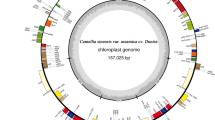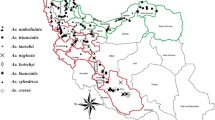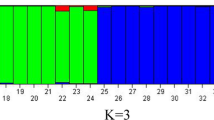Abstract
Gossypium species represent a vast resource of genetic multiplicity for the improvement of cultivated cotton. To determine genetic diversity and relationships within a diverse collection of Gossypium, we employed 120 SSR primers on 20 diploid species representing seven basic genome groups of the genus Gossypium, five AD allotetraploid cotton accessions while T. populnea served as an outgroup species. Out of 120 SSR primers, 49 pairs are polymorphic, which produced a total of 99 distinct alleles with an average of 2.0 alleles per primer pair. A total of 1139 major SSR bands were observed. Genetic similarities among all the diploid species ranged from 0.582 (between G. herbaceum and G. trilobum) up to 0.969 (between G. arboreum and G. herbaceum). Phylogenetic trees based on genetic similarities were consistent with known taxonomic relationships. The results also indicated that G. raimondii is the closest living relative of the ancestral D-genome donor of tetraploid species and the A-genome donor is much similar to the present-day G. herbaceum and G. arboreum. Ancient tetraploid cotton species were formed by hybridizing and chromosome doubling between them, then different tetraploid cotton species appeared by further geographical and genetic isolation and separating differentiation. The results showed that SSRs could be an ideal means for the identification of the genetic diversity and relationship of cotton resources at the genomic level.
Similar content being viewed by others
References
Abdalla AM, Reddy OUK, El-Zik KM and Pepper AE (2001). Genetic diversity and relationships of diploid and tetraploid cottons revealed using AFLP. Theor Appl Genet 102: 222–229
Beasley JO (1940). The origin of American tetraploid Gossypium species. Amer Naturalist 74: 285–286
Beasley JO (1942). Meiotic chromosome behavior in species, species hybrids, haploids and induced polyploids of Gossypium. Genetics 27: 25–54
Bertin P, Gregoire D and Massart S (2001). Genetic diversity among European cultivated spelt revealed by microsatellites. Theor Appl Genet 102: 148–156
Broun P and Tanksley SD (1996). Characterization and genetic mapping of simple repeat sequences in the tomato genome. Molec Gen Genet 250: 39–49
Brubaker CL, Bourland FM and Wendel JF (1999). The origin and domestication of cotton. In: Smith, WC (eds) Cotton: origin, history, technology and production, pp. Wiley, New York
Brubaker CL, Paterson AH and Wendel JF (1999). Comparative genetic mapping of allotetraploid cotton and its diploid progenitors. Genome 42: 184–203
Chowdari KV, Davierwala AP, Gupta VS, Ranjekar PK and Govila OP (1998). Genotype identification and assessment of genetic relationships in pearl millet [Pennisetum glaucum (L.) R. Br.] using microsatellites and RAPDs. Theor Appl Genet 97: 154–162
Cronn RC, Small RL, Haselkorn T and Wendel JF (2002). Rapid diversification of the cotton genus (Gossypium: Malvaceae) revealed by analysis of sixteen nuclear and chloroplast genes. Amer J Bot 89: 707–725
Cronn RC, Zhao XP, Paterson AH and Wendel JF (1996). Polymorphism and concerted evolution in a tandemly repeated gene family: 5S ribosomal DNA in diploid and allopolyploid cottons. J Molec Evol 42: 685–705
Davierwala AP, Ramakrishna W and Ranjekar PK (2000). Sequence variations at a complex microsatellite locus in rice and its conservation in cereals. Theor Appl Genet 101: 1291–1298
Dean RE, Dahlberg JA, Hopkins MS, Mitchell SE and Kresovich S (1999). Genetic redundancy and diversity among `Orange' accessions in the U.S. national sorghum collection as assessed with simple sequence repeat (SSR) markers. Crop Sci 39: 1215–1222
Depeige A, Goubely C, Lenior A, Cocherel S, Picard G, Raynal M, Grellet F and Delseny M (1995). Identification of the most represented repeated motifs in Arabidopsis thaliana microsatellite loci. Theor Appl Genet 91: 160–168
Endrizzi JE, Turcotte EL and Kohel RJ (1985). Genetics, cytology, and evolution of cotton. Adv Genet 23: 271–375
Fahima T, Roder MS and Wendehake K (2002). Microsatellite polymorphism in natural populations of wild emmer wheat, Triticum dicoccoides, in Isreal. Theor Appl Genet 104: 17–29
Fryxell PA (1979). The natural history of the cotton tribe. Texas A&M University Press, College Station
Fryxell PA (1992). A revised taxonomic interpretation of Gossypium L. (Malvaceae). Rheedea 2: 108–165
Gerstel DU (1953). Chromosomal translocation in interspecific hybrids of the genus Gossypium. Evolution 7: 235–244
Hanslik S, Harr B, Brem C and Schlotterer C (2000). Microsatellite analysis reveals substantial genetic differentiation between contemporary New World and Old World Holstein Friesian populations. Anim Genet 31: 31–38
Huang XQ, Borner A and Roder MS (2002). Assessing genetic diversity of wheat (Triticum aestivum L.) germplasm using microsatellite markers. Theor Appl Genet 105: 699–707
Iqbal MJ, Aziz N, Saeed NA and Zafar Y (1997). Genetic diversity evaluation of some elite cotton varieties by RAPD analysis. Theor Appl Genet 94: 139–144
Iqbal MJ, Reddy OUK, El-Zik KM and Pepper AE (2001). A genetic bottleneck in the `evolution under domestication' of upland cotton Gossypium hirsutum L. examined using fingerprinting. Theor Appl Genet 103: 547–554
Jones ES, Dupal MP and Kolliker R (2001). Development and characterization of simple sequence repeat (SSR) markers for perennial rye grass (Lolium perenne L.). Theor Appl Genet 102: 405–415
Kanthaswamy S, Bininda-Emonds ORP, Warden C, Viray JL and Smith DG (2001). Use of SSR fragment length homozygotes for orangutan systematics. Primates 42: 35–45
Kijas JMH, Fowler JCS and Thomas MR (1995). An evaluation of sequence tagged microsatellite site markers for genetic analysis within Citrus and related species. Genome 38: 349–355
Levinson G and Gutman GA (1987). Slipped-strand mispairing: A major mechanism for DNA sequence evolution. Molec Biol Evol 4: 203–221
Liu S, Saha S, Stelly D, Burr B and Cantrell RG (2000). Chromosomal assignment of microsatellite loci in cotton. J Heredity 91: 326–332
Lu HJ and Myers GO (2002). Genetic relationships and discrimination of ten influential upland cotton varieties using RAPD markers. Theor Appl Genet 105: 325–331
Macaulay M, Ramsay L and Powell W (2001). A representative, highly informative `genotyping set' of barley SSRs. Theor Appl Genet 102: 801–809
Morgante M and Olivieri AM (1993). PCR-amplified microsatellites as markers in plant genetics. Pl J 3: 175–182
Multani DS and Lyon BR (1995). Genetic fingerprinting of Australian cotton cultivars with RAPD markers. Genome 38: 1005–1008
Nguyen TB, Giband M, Brottier P, Risterucci AM and Lacape JM (2004). Wide coverage of the tetraploid cotton genome using newly developed microsatellite markers. Theor Appl Genet 109: 167–175
Palombi M and Damiano C (2002). Comparison between RAPD and SSR molecular markers in detecting genetic variations in kiwifruit (Actinida deliciosa A. Chev.). Pl Cell Rep 20: 1061–1066
Paterson AH, Brubaker CL and Wendel JF (1993). A rapid method for extraction of cotton (Gossypium spp.) genomic DNA suitable for RFLP or PCR analysis. Pl Molec Biol Rep 11: 122–127
Pejic I, Ajmone-Marsan P, Morgante M, Kozumplick V, Castiglioni P, Taramino G and Motto M (1998). Comparative analysis of genetic similarity among maize inbred lines detected by RFLPs, RAPDs, SSRs, and AFLPs. Theor Appl Genet 97: 1248–1255
Pillay M and Myers GO (1999). Genetic diversity in cotton assessed by variation in ribosomal RNA genes and AFLP markers. Crop Sci 39: 1881–1886
Poulsen GB, Hahl G and Weising K (1993). Abundance and polymorphism of simple repetitive DNA sequences in Brassica napus L. Theor Appl Genet 85: 994–1000
Rajora OP and Rahman MH (2003). Microsatellite DNA and RAPD fingerprinting, identification and genetic relationships of hybrid poplar (Populus canadiensis) cultivars. Theor Appl Genet 106: 470–477
Reddy OU, Pepper AE, Abdurakhmonov I, Saha S, Enkins JN, Brooks T, Bolek Y and El-zik KM (2001). New dinucleotide and trinucleotide microsatellite marker resources for cotton genome research. Crop Sci 5: 103–113
Rohlf FJ (1993). NTSYS-pc. numerical taxonomy and multivariate analysis system. Version 2.02h. Applied Biostatistical Inc, New York
Saghai-Maroof MA, Biyashev RM and Yang GP (1994). Extraordinarily polymorphic microsatellite DNA in barley: species diversity, chromosomal location and population dynamics. Proc Natl Acad Sci USA 91: 5466–5470
Seelanan T, Schnabel A and Wendel JF (1997). Congruence and consensus in the cotton tribe. Syst Bot 22: 259–290
Senchina DS, Richard IA, Cronn C, Liu B, Rong JK, Noyes DR, Paterson AH, Wing RA, Wilkins TA and Wendel JF (2003). Rate variation among nuclear genes and the age of polyploidy in Gossypium. Molec Biol Evol 20(4): 633–643
Small RL and Wendel JF (2000). Phylogeny, duplication and intraspecific variation of Adh sequences in New World diploid cottons (Gossypium L.. Malvaceae) Molec Phylogenet Evol 16(1): 73–84
Stewart JM (1995) Potential for crop improvement with exotic germplasm and genetic engineering. In: Constable GA, Forrester NW (eds) Challenging the future: proceedings of the world cotton research conference, CSIRO, Melbourne pp 313–327
Sun GL, Diaz O and Salomon B (2001). Genetic diversity and structure in a natural Elymus caninus population from Denmark based on microsatellite and isozyme analyses. Pl Syst Evol 227: 235–244
Taramino G and Tingey S (1996). Simple sequence repeats for germplasm analysis and mapping in maize. Genome 39: 277–287
Tatineni V, Cantrell RG and Davis DD (1996). Genetic diversity in elite cotton germplasm determined by morphological characteristics and RAPDs. Crop Sci 36: 186–192
Tautz D (1989). Hyper variability of simple sequences as a general source for polymorphic DNA markers. Nucl Acids Res 17: 6463–6471
Tautz D and Renz M (1989). Simple sequences are ubiquitous repetitive components of eukaryotic genomes. Nucleic Acids Res 12: 4127–4138
Tsumura Y, Suyama Y, Yoshimura Y and Mukai Y (1997). Sequence-Tagged-Sites (STSs) of cDNA clones in Cryptomeria japonica and their evaluation as molecular markers in conifers. Theor Appl Genet 94: 764–772
Wendel JF (1989). New World tetraploid cottons contain Old World cytoplasm. Proc Natl Acad Sci USA 86: 4132–4136
Wendel JF (1995). Cotton. In: Smartt, J and Simmonds, NW (eds) Evolution of crop plants, 2nd ed. pp 358–366. Longman Scientific, Essex
Wendel JF and Albert VA (1992). Phylogenetics of the cotton genus (Gossypium): Character-State Weighted Parsimony Analysis of chloroplast DNA restriction site data and its systematic and biogeographic implications. Syst Bot 17: 115–143
Wendel JF and Brubaker CL (1993). RFLP diversity in Gossypium hirsutum L. and new insights into the domestication of cotton. Amer J Bot 80: 71
Wendel JF, Brubaker CL and Percival AE (1992). Genetic diversity in Gossypium hirsutum and the origin of upland cotton. Amer J Bot 79: 1291–1310
Wendel JF and Cronn RC (2003). Polyploidy and the evolutionary history of cotton. Adv Agron 78(2): 139–186
Wendel JF and Percy RG (1990). Allozyme diversity and introgression in the Galapagos Islands endemic Gossypium darwinii and its relationship to continental G. barbadense. Biochem Syst Ecol 18(7–8): 517–528
Author information
Authors and Affiliations
Corresponding author
Rights and permissions
About this article
Cite this article
Wu, YX., Daud, M., Chen, L. et al. Phylogenetic diversity and relationship among Gossypium germplasm using SSRs markers. Plant Syst. Evol. 268, 199–208 (2007). https://doi.org/10.1007/s00606-007-0565-7
Received:
Accepted:
Published:
Issue Date:
DOI: https://doi.org/10.1007/s00606-007-0565-7




